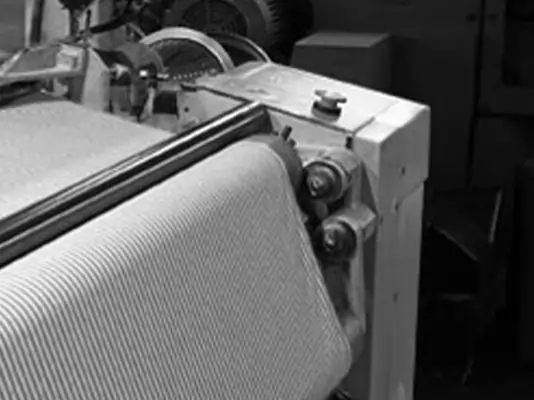A stitch in time: Cutting lead time and improving reliability of textile supply chains
Chandrachur Datta & Dr. Shelja Jose Kuruvilla

From fiber to fashion, the textile industry value chain tends to be long, containing many stakeholders. Barring a few vertically integrated units, which have an end-to-end control of the entire supply chain, the usual flow spans multiple units specializing in one or two parts of the total value chain:

The raw material, few in number, undergo irreversible transformations at every stage or unit of this value chain. And, in the process, the output variety increases by leaps and bounds. Let's take an example of cotton garments manufacturing. From a single fiber i.e, cotton, by varying the twists, more than 50 types of yarn of different thickness and strength can be created. A combination of these yarns can be knitted into 100s of greige fabric – each varying in structure, thickness, width. When the greige fabric is dyed into different hues, variety explodes into 1000s. Finally, from the same fabric, many types of garments can be manufactured.
A typical sequence of processes in a garment factory is shown below:

Generally, retail brands or downstream partners design the products they would like to order. Then, manufacturers come up with samples. Subsequently, the approved designs are manufactured. Currently, for most mills, not only is the total manufacturing lead time fairly long, it is also extremely unreliable. So much so, that for brands, the ‘concept to delivery-to-stores’ lead time can vary from 9 to 12 months. Variety involved is huge, while fashion cycles are short, often shorter than the lead time! So, a ‘stock and sell’ model, will overburden the supplier with huge inventories. This is impractical, to say the least.
As a result, most suppliers operate as ‘Make-To-Order’ (MTO) units to its downstream partners. An order is usually a collection consisting different designs. At each unit, the order gets more granuralised. But assortment completion or delivering all the SKUs of an order together is of paramount importance. For example: Let's say, a retail brand places an order for its spring-summer collection with a garment supplier and it has ordered different quantities of 12 individual designs. On the shop floor of the garment supplier, each of these SKUs will run individually, and may get dispatched separately. But generally, such designs are part of a collection or a storyline and is expected to occupy the retail shelf space together. So, for the brand, until all 12 designs are delivered, the collection is incomplete and useless.
A similar situation can arise between a garment supplier and a fabric/trim supplier when supply of some fabric SKUs arrive on time, but one fabric is missing in each assortment! This could happen between a fabric supplier and his yarn suppliers – weaving or knitting cannot start until all yarn SKUs, in the required quantity, is available. In the case of a yarn supplier, mixing of yarns to achieve a desired shade cannot begin until all shades of the fibers required are present.
Chronic industry issues
All textile units run their shop floors with a target to complete all the SKUs in their various orders. But, in spite of sophisticated scheduling software and continuous expediting, these units experience the following chronic problems:
- The overall lead time of an assortment is high.
- The inventory levels skyrocket as rate of creation of incomplete assortments (which cannot be dispatched) is much higher than the rate of closure of assortments or dispatch.
- Overall system reliability that customers experience is poor though traditional measurement of on-time performance may indicate differently.
- Consequently, very often the supplier has to pay for this chronic unreliability (delays/quality issues/incomplete assortment) by having to resort to expensive airfreights and/ or by paying penalties to customers.
But what really creates these issues?
The Root Cause- A Vicious Loss of Capacity
Bulk manufacturing of textiles is a high-investment business. So, to ensure good return on this investment, efficiency of each work center is diligently protected, and any capacity loss or idling is a no-no. Moreover, these machines have an optimized sequence of work (e.g., yarn making has a count sequence, dyeing needs to maintain a particular color sequence etc.). So, to utilize the machines to the highest levels, most textile units follow a monthly planning system in which all opportunities for batching across the backlog of orders are utilized.
Based on the SKUs manufactured in the previous month, a plan is made at the beginning of each month for that month’s production. The plan is shared with vendors or downstream units. Vendors too experience delays. Moreover, different materials have different lead times. So, in this wait for the complete kit of materials to become available for production, capacity of the mill is lost or underutilized in the first half of the month and overburdened towards the end of the month when all the material starts becoming available. Therefore, work moves in ‘waves’ into the various work centers in the textile mill.
At every work center, a few raw materials can be transformed into many varieties of output. So, it is easy to 'steal’ the raw material of a current order of say SKU-2 to make a bigger batch of SKU-1. In the process, the SKU-2 will now wait for raw material to be available again while stock of SKU-1 piles up in the warehouse waiting for the assortment to complete. So, in spite of inventory ballooning over the course of the month, this practice of cherry-picking across customer orders also creates erratic cycles of starvation and overloading in work centers. This also increases the time gap between manufacturing various items needed for completing orders (poor On-time-in-full performance).
Subsequently, when pressure from customers or downstream units to process missing items of an assortment intensifies, batching considerations are sidestepped, and production plans are rescheduled. This affects scheduling of other material, creating more de-synchronization. So, by the time all the input material becomes available, time runs short. All planned orders for the month cannot be completed; many orders spill over to the next month.
At the end of the month, the large WIP and raw material in the system is again ‘netted off’ against pending orders and, a new plan is made. Consequently, the same cycle of underutilization in the initial part of the month and expediting towards the end of it, repeats every month.
The vicious loop that such environments tend to experience is this:

What is most ironical is that in spite of fighting hard to 'protect' the returns on investment and profitability by focussing of utilization and machine productivity, in the end, this is all in vain. The company does not experience any real improvement in overall utilization. And, to add to that, due to system unreliability, there is a consequent increase in costs because of to having to frequently send material through airfreights and/or by being forced to pay penalties.
Direction of solution
These problems arise because various work centers of a textile mill are blind to how local decisions affect the fate of customer orders. So, how can mills solve these? The only win-win way out of the conflict of order completion versus utilization is a method which limits WIP and defines the boundaries within which local batching considerations can prevail to protect efficiencies without delaying orders.
Sounds simple! doesn't it? Let's see how to do it.
Tactical Steps
Though the lead time for completion of order is often long, the actual processing time or the touch time of an order on the machines is low. The gap between touch time and lead time is long because orders often wait to be processed in front of various work centers or in warehouses. In order to reduce the waiting time, and to implement a paradigm of focus on completing orders rather than driving efficiency, the following tactical steps are needed:
1. Production scheduling with WIP control: As against existing practice of monthly planning and batch releases, release of material should only be based on daily gap in WIP i.e. new orders are released only when the same quantity exits. This can be implemented by first identifying the bottleneck or work center in the system whose output determines the system output (called the Drum). Since by definition, the other work centers have higher capacity, a day’s output from this can be the input to the system on the next day (Rope).
With this rule in place the mill will have enough visibility to do some batching to meet any technical requirements and protect utilization while at the same time forcing completion of work on the orders in hand. Consequently, the execution lead time -i.e. time from date of release of the order to date of completion (Buffer) will reduce. At the same time, this step also enables planning to be conservative and spare some capacity, while allowing execution to aggressively use any unused capacity and maximize output.
2. Keeping track of 'Flow’ of orders: To ensure on-time delivery of a complete customer order, it is also essential that instead of tracking components, completion of the assortment is managed. All local level measures and targets like ‘Daily dyeing output should be 10 tonnes’ or ‘daily garmenting output should be 25,000 pieces’, which can hamper adherence to this objective (by encouraging batching), should be eliminated. High productivity of each work center will likely be achieved; but only as a by-product.
3. Managing priority: Now, the delivery date of the order should be the only determinant of priority on the shop floor. To enable this, a simple color-based priority mechanism can be devised based on relative closeness to the due date. Red is highest priority, then Yellow & Green the least. The color priority dictates expediting on the shop floor and at the vendors’ facilities.
4.Quoting due dates: The sales department usually generates new orders, and quote delivery dates with a fixed lead time or based on customer expectations. But, in such a system, quoting a fixed lead time delivery date may not always be enough, considering there is a queue of orders already in the system (waiting to be processed at the bottleneck work center - the drum). And letting customers pick a date may also upset this queue, and thereby, the already committed delivery dates. So, the delivery date offered should not jeopardize the existing queue and should also allow for sufficient lead time to complete the execution post the processing at the ‘drum’.
A daily perpetual order slotting for Due Date Quotation with clear definition of capacity is essential. That is, the production team has to provide the sales team with “safe dates” or highly reliable dates they can offer to customers for orders that the sales team might close next. Then, not only will lead times be low but the reliability would also be near 100%. This will also help smoothen the load on the shop floor since sales will have visibility of gaps in the production load and, thereby, help encourage sales even during lean periods.
5. Managing preparatory activities: The preparatory activities (sourcing of yarn and trims, submission of GSS samples to customers) can also be prioritized based on the relative closeness to release date with the help of a preparatory buffer which is back-to-back to the production buffer. For instance, in a garmenting plant, a preparatory buffer should help create a bank of full kits of sales orders with completed fabric, trims, and approvals to ensure continuous running of the stitching operation on correct orders. So, the overall system would look like:

Conclusion
Once an organization implements these tactics, synchronization can be achieved with all the preparatory activities including raw material supplies. Moreover, waiting times will be reduced, and lead times of completing an order can consequently be slashed by more than half.
With such an overall reduction in lead time, key customers who require orders in considerably lower lead time can be offered deliveries in half the normal lead time (possibly at a higher price). To achieve this, capacity can be set aside for running these orders without hampering other normal lead time orders.
This means that, in an industry which is chronically struggling with long lead times and poor reliability, a company adopting this method can build for itself a competitive edge based on reliability with lower lead times, while ensuring more output from same capacity.
Featured Case

Transforming Textile & Garment Manufacturing Business Using TOC








